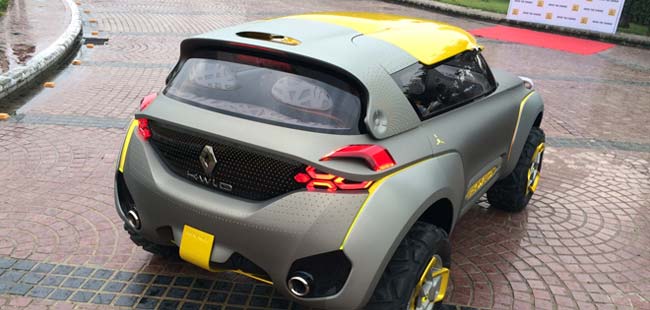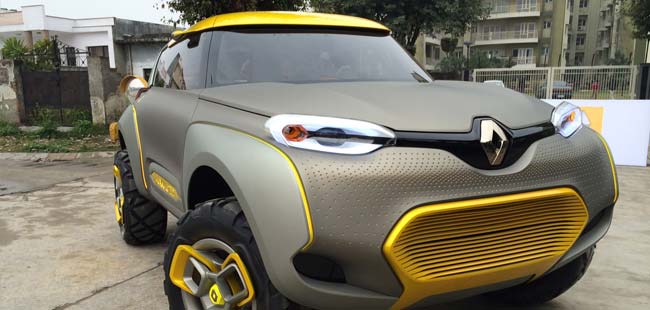First Drive: Renault KWID Concept

Highlights
It isn't everyday - even as a motoring journalist, that one gets the chance to look at a concept car. And it's rarer still, when the opportunity to drive one presents itself! And things start getting to pinch-yourself-to-believe -it levels, when that opportunity is in India.
Renault took the wraps off its latest concept car - the Kwid - at the recently concluded Auto Expo in Delhi. The debut was a bold statement from the French carmaker as it was the first time it was showing a concept outside of Europe. That it chose India to do it is also not lost on me for sure. The Kwid is every bit the concept car in its looks, appeal and to some extent, the exaggerated proportions. But despite that, there lies a message within this design study - one that points to future styling cues, segments of interest and even size of vehicles that Renault is looking at keenly. The car is part dune buggy and part SUV, and stays below 4 metres in overall length. This we know is an Indian regulation that allows manufacturers to benefit from lower taxation, since the car gets categorised as 'small'. The segment in question has exploded with the ford EcoSport in 2013, and we have had plans unfurling from virtually every carmaker that wants to pursue volumes in India. Renault already has a compact SUV hit in the Duster, but that car has lost some steam off late - mostly due to the EcoSport's pricing and appeal.
Also Read: Renault Kwid Review
Okay now for more details on the Kwid. The car's grey and yellow exterior is not so much about the Renault corporate colours, but instead also draw on the Indian theme. The design team that worked on the Kwid comprises French, Brazilian and Indian designers - who worked on various aspects - interior, exterior design, trim, etc - at Renault's facilities in the three countries. The car's colour and trim designer is Neha Lad, and she says the grey is meant to represent the Indian landscape and earth, while the yellow signifies the hues of Indian spices and flowers like the marigold. I'll believe it, coz that's what they say - but time it really is just more about the Renault logo! The interior designer is Mishu Batra - again an Indian, and he too has stayed true to the requirements of the Indian family, but with a twist - by making the car a 5-seater - with 3 seats in front and two in the back. The car's looks conceal a fairly roomy interior. The low roofline notwithstanding, the insides are surprisingly spacious. The design study is in concept stage, and so the seats are finished in a lattice work frame, with the actual seat inside that framework - to give a sense of airiness - and that is also in keeping with the fact that the concept has been inspired by India. The idea is to have seats that stay cool in hot climate. The driver's seat is in the middle, with the steering mounted as such too, but then need I remind you this is a concept car folks? So getting quirky goes with the territory! There are cameras instead of rear view mirrors and their output gets displayed at the top ends of the dash, and there is some futuristic switchgear when it comes to the controls, and even the dual-zone mock climate control system.
Also Read: Renault Kwid Compact Car - What you Need To Know

The Kwid has been powered by Renault's 1.2 litre H5ft turbocharged petrol engine which has 120 bhp on tap. This is the same motor that is already on duty in variants of the new Clio and Captur line-up from Renault in Europe. The engine has Start/Stop standard, and is mated to Renault's new 6 speed EDC (Efficient Dual-Clutch) gearbox. The car is presently developed as a 2 wheel drive - again indicating its leaning to a price-sensitive and competitive segmentation. Interestingly though, the Kwid has been designed to be able to take on batteries, so as to be able to afford an electric application too, with charger-socket adaptability in the rear.
When I drove the car, I didn't go in with great expectations, because even though this is functioning concept - it is still just that - a concept! So it moves with some trepidation and its stiff body shell creaks and rattles as you go. The fact that I was on an uneven concrete road wasn't helping the situation. But like I said I had to discount all that. What I did get though was the car's ease of manoeuvrability, good turning radius (the short overhangs help), and the response of the powertrain. For every groan that came from the body, the 1.2 litre unit seemed ready to go, with the gearbox all set to comply. That bodes well, but then I am not going to start talking production models just yet. The larger point was the sheer fun of driving a concept. Pushing the buttons to change gears, looking into the camera outputs, and generally grinning stupidly as people gawked at me as I went by - that pretty much sums up the experience.

The concept has been designed with a "flying companion" - essentially a remote controlled heli-cam that sits in a niche in the car's roof, and cam be manipulated to fly on for you to survey the traffic or road conditions that lie ahead. A gimmick really, one that makes this package more concept-like really - and might I add missing from the car when I drove it, since after the Expo, it and its operator have travelled back to France!
But as I pushed the button to electrically raise the gull-wing door (I had my fun taking turns getting out of either side since this was neither a right hand nor left hand drive!), the symbolism of it all once again came rushing back into my head. The unveiling in India, the sub-4-metre size, the design work in India, and inspiration taken from this market - it all adds up to a message that tells us that big things are coming - albeit in small packages! As India moves back and forth between its love for the diesel engine, I see great potential for this feisty little engine in our market. The H5ft is a straight-3 that belongs to the family of engines jointly developed by Renault and Nissan (the latter calls them HR, while Renault simply calls them H). While predominantly used by Nissan vehicles, a large number of Renaults are beginning to adopt this new range too. There is a 1.5 litre straight-4 in the pack too incidentally.
So the potential is huge, the opportunities immense. But as Renault fine-tunes its India strategy, with a very keen eye on increased market share in the immediate future, I for now am simply happy to have been the first Indian journalist to have driven the Kwid. The fact that few French journalists get the chance back home at Renault HQ was quickly pointed out by the design team on hand during my drive! We will have a more detailed look at the car and its features, next week on CNB.
Last Updated on September 19, 2015
Related Articles
Latest News
Research More on Renault Kwid
- Home
- News
- Shanghai Motor Show
- First Drive: Renault KWID Concept


















